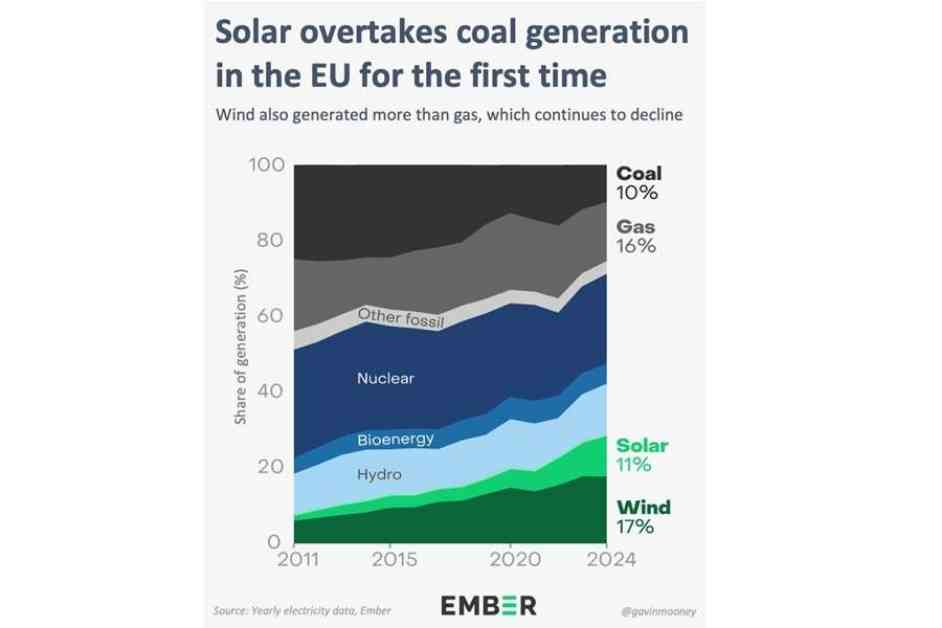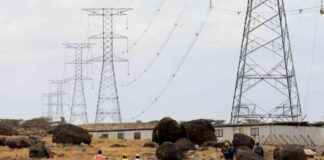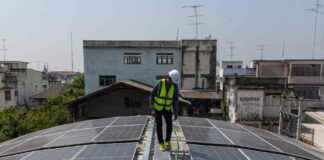In a groundbreaking shift towards sustainable energy, solar power has officially surpassed coal generation in the European Union, marking a significant milestone in the region’s energy transition. This historic achievement was realized for the first time last year, despite facing challenges such as a slight uptick in electricity demand and decreased sunshine in 2024.
Over the course of the past decade, the landscape of energy production in the EU has undergone a remarkable transformation. Coal power usage has plummeted by a staggering 61%, while wind generation has more than doubled, and solar generation has seen a threefold increase. These remarkable statistics underscore the rapid evolution of the energy sector as it embraces cleaner, more renewable sources of power.
The once-dominant role of coal in the EU’s energy systems has now been reduced to a marginal or nonexistent presence, signaling a decisive shift away from fossil fuels. This shift has been further fueled by the surging growth of wind and solar generation, which have collectively enabled the EU to sidestep a whopping €59 billion in fossil fuel imports over the past five years. This economic benefit is largely attributed to the declining share of gas in the energy mix, which has seen a consistent decrease over the last half-decade.
The rise of renewables, particularly wind and solar power, has not only reshaped the energy landscape but has also yielded significant environmental benefits for the region. By reducing the reliance on fossil fuels, the EU has managed to curb emissions and improve air quality, all while reaping the economic advantages of affordable, secure, and sustainable energy sources.
Renewables Revolutionizing Energy Sector
The transition towards renewables in the EU has not only been driven by environmental concerns but has also been bolstered by the economic viability and energy security offered by wind and solar power. The increasing affordability of renewable technologies, coupled with their sustainability and resilience, has made them an attractive choice for countries looking to diversify their energy portfolios and reduce their carbon footprint.
Expert voices in the energy sector have hailed the rise of renewables as a transformative development that is reshaping the way we produce and consume electricity. According to industry analysts, the shift towards cleaner energy sources is not only a response to climate change but also a strategic move to ensure energy independence and security in an increasingly volatile global energy market.
Nuclear and Hydro Make a Comeback
While solar and wind power have been the stars of the EU’s energy transition, nuclear and hydro have also experienced a resurgence in recent years. Following a dip in 2022, both nuclear and hydro power have rebounded, with nuclear emerging as the largest single source of energy supply in the EU, accounting for over 23% of the total energy mix.
The resurgence of nuclear and hydro power highlights the diverse mix of energy sources that are essential for meeting the EU’s energy needs while reducing carbon emissions. By combining the strengths of renewables like solar and wind with the reliability of nuclear and hydro power, the EU is poised to achieve a more sustainable, secure, and resilient energy future.
In conclusion, the shift towards renewable energy sources in the EU represents a paradigm shift in the energy sector, with solar power overtaking coal generation as a clear sign of the region’s commitment to a cleaner, more sustainable energy future. As the EU continues to embrace renewables and diversify its energy mix, it is poised to lead the way in the global transition towards a low-carbon economy, setting a powerful example for other regions to follow.














